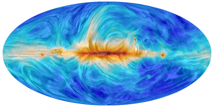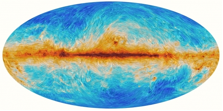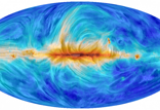Planck results: first stars born later than expected
News about Dark Matter, neutrinos, first stars and the cosmological model: the Planck collaboration, with a leading participation of the Institut d'Astrophysique Spatiale, has just published nearly twenty articles revealing many important results that will allow to better understand major chapters in the book of the Universe.
The history of the Universe is truly a cosmic saga that began some 13.8 billion years ago which scientists have been deciphering in increasing precision for decades. One of their principal sources of information is the Cosmic Microwave Background (CMB), a relic light dating back to times when the Universe was very hot and dense, roughly 380 000 years after the Big Bang. Information collected by the Planck satellite after four years of observation of the CMB, including the finest snapshot of that relic radiation, has been therefore awaited with great anticipation by the scientific community. For the first time, its analysis provides now scientists with not only a static, but also with a truly dynamical picture of the young Universe that enables the exploration of all the cogs and springs of the cosmological model.
The first stars: more recent than expected.
Among the new lessons deduced from the Planck data, cosmologists have determined the current expansion rate of the Universe. It has led them to estimate the present age of the Universe at 13.77 billion years. More surprisingly, their refined determination of the epoch of the birth of the first stars places it at about 550 million years after the Big Bang, which is much later that what scientists thought before. Finally, thanks to the Planck high precision data, astrophysicists were able to pin down the precise content of the Universe, revealing that 4.9% of the energy budget is made of ordinary matter, 25.9% of Dark Matter of persistently elusive nature, and 69.2% of Dark Energy, yet another form of energy, distinct from but even more mysterious than Dark Matter. But the most important novelty has been brought by the information from the polarisation of the CMB light. Thanks to it, scientists are now able to test a number of assumptions they make about the Universe, pertaining to both the physical laws that govern its evolution and to the properties of its constituents (neutrinos and Dark Matter, for instance). Today, this new data provide world-wide scientists with particularly solid foundations for the exploration of the most remote epoch of the cosmic history, ever closer to the Big Bang.
Understanding the cycle of matter in the interstellar medium
Another major domain in which Planck observations will allow the scientific community to deepen its knowledge concerns the magnetic field of our Galaxy. This is very important because the magnetic field is a key player in the life-cycle of interstellar matter. The discovery of the magnetism of our Galaxy is closely related to that of cosmic rays. Without a magnetic field, these particles, accelerated by supernovae up to velocities toying with the speed of light, would quickly leave the interstellar medium. However, the force due to the presence of the magnetic field confines them to our Galaxy. In addition, the magnetic field itself is tightly bound to interstellar matter. Furthermore, in the presence of magnetic fields, collisions and coupling to the radiation field of stars tend to align interstellar dust grains, and that alignment is at the origin of the polarisation of dust emitted radiation. For the first time, the Planck satellite has measured this polarisation on the whole sky.
It is well known that interstellar matter, magnetic fields and cosmic rays constitute a dynamical mixture: they are tightly coupled to each other, and we cannot understand one of them fully without taking into account the two others. The importance of the magnetic field in this ménage à trois has been known for some time, but observations available to scientists were still rather scarce until now. Current results of the Planck mission will help in this context since two unprecedented maps of the polarised sky have been released. Synchrotron polarisation, similarly to dust polarisation, traces the magnetic field lines. Thus, Planck data reveal the global structure of the Galactic magnetic field in exquisite details, never seen before.
Contacts at the IAS : Jean-Loup Puget, François Boulanger, Marc-Antoine Miville-Deschênes, Jonathan Aumont
Additional information on the most recent Planck results:
- Scientific articles submitted for publication: http://www.cosmos.esa.int/web/planck/publications
- A summary in English with videos: https://www.esa.int/Science_Exploration/Space_Science/Planck/Planck_reveals_first_stars_were_born_late


Planck images of the polarised synchrotron (left) and dust (right) emissions. Colours represent the intensity of the emission while embossed texture reflects its polarisation. The orientation of the global magnetic field is shown in regions where the texture is smooth. Data are more difficult to interpret in regions where it is irregular. Credits : ESA / Planck collaboration / M.-A. Miville-Deschênes, CNRS – Institut d’Astrophysique Spatiale, Université Paris-Sud, Orsay, France




